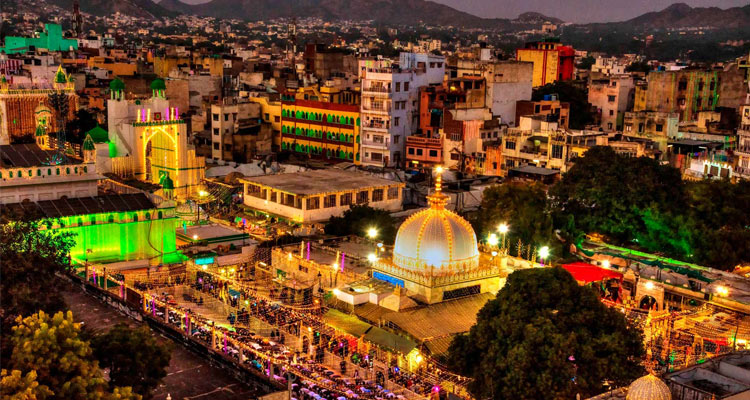
Ajmer is bustling city, located 130 km southwest of Jaipur and just 14 km from the pilgrimage town of Pushkar. The city of Ajmer gets its name from “Ajay Meru”, which can be roughly translated as “invincible hill”. Home to a number of tourist places, Ajmer can be a perfect representation of the diversity of the Indian culture and ethics, and displays a perfect blend of religion, community, culture, etc., coexisting and flourishing in harmony.
Ajmer remains a popular tourist attraction, in addition to being a pilgrimage centre for both Hindus and Muslims. The final resting place of the Sufi Saint, Khwaja Moinuddin Hasan Chisti, is visited by Muslims from all over the world; in fact, the Dargah is revered equally by both Hindus and Muslims. The city is surrounded by the expansive lake of Ana Sagar and the rugged hills of Aravalli. Although Ajmer Sharif Dargah, the shrine of Khwaja Muin-ud-din Chishti, remains as the most famous tourist places to visit in Ajmer, the city is also significantly known for the Jain religion and is home to an amazing golden Jain Temple. Ajmer is also a well-known learning centre. The Mayo College was one of India’s first schools that acted as the stepping stone for the British style of education and is now one of the popular places to visit in Ajmer.
History of Ajmer
The city was founded by Raja Ajaypal Chauhan in the 7th century AD and the city remained as the epicentre of the Chauhan Dynasty till the 12th century AD. The Chauhan dynasty was responsible for the construction of the first hill fort of India, Taragarh, another must visit places in Ajmer. After the defeat of Prithviraj Chauhan by Mohammed Ghori, Ajmer become home to a number of dynasties. The Mughal Sultans particularly liked Ajmer due the presence of the holy Ajmer Sharif Dargah, the most popular tourist place in the city. Ajmer has a rich history and played host to the first meeting between the Mughal King Jahangir and the Ambassador of the Court of King James 1 of England, Sir Thomas Roe in 1616. The city was officially handed over to the British a few centuries later, making Ajmer the only region in Rajputana to be directly controlled by the British East India Company.
Places To Visit In Ajmer
Ajmer Sharif Dargah: This is a Sufi shrine which encloses the ‘maqbara’ (grave) of Garib Nawaz, the Sufi saint Khwaja Moinuddin Chisti. Built in the 13th century, the shrine is popular among people of all faiths who flock here to have their prayers answered. The shrine has three gates – the main gate or the Nizam gate, the Shah Jahan gate erected by the Mughal Emperor and the Buland Darwaza. Another big draw at this holy shrine is the sacred and scrumptious food that is served to devotees. Cooked in giant cauldrons known as ‘degs’, devotees gather in throngs to be blessed by this prasad.
Adhai Din Ka Jhonpra: The Adhai Din Ka Jhonpda was originally built to function as a Sanskrit college but was later converted into a mosque by Sultan Ghori in 1198 AD. An impressive blend of Indo-Islamic architecture, the structure was further beautified by Sultan Iltutmish in 1213 AD. Legend has it that the mosque is known as Adhai din ka Jhonpda (literally meaning, The Hut of Two and a Half Days) because of a two and half day fair held here during Urs in the 18th century.
Ana Sagar Lake: Anasagar Lake is a scenic artificial lake, commissioned and built by Arnoraj Chauhan, son of Ajaypal Chauhan, between 1135 and 1150 AD. Arnoraj was also known as Anaji, which gives the lake its name. Many years later, Mughal Emperor Jahangir added his touch to the lake by laying out the Daulat Bagh Gardens near the lake. Emperor Shah Jahan too, contributed to the expansion by building five pavilions, known as the Baradari, between the garden and the lake.
Soniji ki Nasiyan: Soniji ki Nasiyan, also known as the Ajmer Jain Temple, is a wonderful example of ornate architecture, and is dedicated to Risabh or Adinath. Its entrance is made of red stone and the marble staircase inside is engraved with images of the holy Tirthankars – omniscient teachers of Jain faith who taught righteousness. Constructed in the late 19th century, this temple is counted among the richest temples in India. Its main chamber, Swarna Nagari (City of Gold), is aptly named so because of the several gold-plated wooden figures it houses within its walls. This famous architectural marvel finds a mention in Kurt Titze’s book, ‘Jainism: A Pictorial Guide to the Religion of Non-Violence.’
Nareli Jain Temple: The Nareli Jain Temple in Ajmer, also known as the Shri Gyandoaya Tirth Kshetra, is situated on the outskirts of Ajmer on the national highway to Jaipur. This modern edifice is celebrated for being a perfect blend of traditional and contemporary architectural styles. It consists of 24 miniature temples in its vicinity. Known as Jainalay, they represent the Jain Thirthankars. The Nareli Jain Temple is an important point of pilgrimage for Digambara Jains.
Ajmer Government Museum: The Ajmer Government Museum serves as one of the prime tourist destinations in Ajmer. The museum is housed within the magnificent fortified palace of the legendary Mughal Emperor Akbar, which was built in 1570. The museum is also known as Bharatpur Museum and is home to a rich collection of archaeological artefacts. Along with stone sculptures, inscriptions and armours, it features the finest paintings of the previous Maharajas of Bharatpur.
Gateway Of Taragarh Fort: Gateway of Taragarh Fort is the imposing main gate of Taragarh fort which is built on a crest of a hill. The main gateway of the Taragarh, which consists of two colossal bastions on both sides with strong guard rooms, has sculptures of elephants adorning it. The main highlights of this once magnificent fort are its water reservoirs and the Bhim Burj, on which the canon called Garbh Gunjam (Thunder from the Womb) was mounted. There is also the magnificent Rani Mahal with its stained windows and murals, which used to house the wives of the rulers. All this makes the Taragarh Fort a nonpareil example of Rajaputana architecture that’s also a major attraction for tourists visiting Ajmer. Fort is also known for Dargah of Hazrat Miran Sayyed Husain Khangswar(Miran Sahib) .
By Air
- Ajmer is well-connected via both, the road and rail network. The nearest airport is Kishangarh Airport, which is about 30 kilometres away and helps Ajmer remain well-connected with major Indian cities. One can easily pre-book a cab or hire one from the taxi stands outside the airport. The journey will take around 39 mins.
By Train
- Buses from the state capital and from other cities also ply to Ajmer regularly. Government run buses run between Jaipur and Ajmer throughout the day. Private operators also ply on the route. There are also less-frequent coach services running between Ajmer and Delhi. One can also use the cloakroom at the main bus stand.
By Road
- Ajmer is located on the Delhi-Jaipur-Marwar-Ahmedabad-Mumbai railway line. It is well connected by rail as most trains on this route halt at Ajmer.


